When looking for jewellery, the pieces we find most attractive are those that speak to us the most, and those that have a special meaning or significance. But, for all the jewellery in the world, nothing gives quite as personal a touch as a charm bracelet.
The concept of a charm bracelet is deceptively simple; essentially, it is a piece of jewellery worn around the wrist to which many different meaningful designs or ‘charms’ are attached.
Because these charms are interchangeable, more can be collected than what can fit on the bracelet, so different ones can be attached for different days and occasions. They are usually made out of Silver or Gold and can feature colourful gemstones and enamels as part of their design.

The appeal of charms lies in just how personal they can be. Many people opt for charms that represent significant milestones in their lives, using their bracelets as a way of visually telling their story. This interchangeability and variety therefore makes it unlikely for any two people will have the same bracelet. Much of their desirability is in their individuality, which is why they make such popular gifts.
So, just how long have we been wearing charm bracelets and what are the meanings behind some of the most popular designs?

The wearing of charms is thought to have come from the idea that they offered protection and acted as a talisman to defend against evil and increase one’s luck. There is evidence to suggest that as long as 75,000 years ago, man was using pieces of shell for personal adornment, and delicately detailed tusk charms have been dated to 30,000 years ago in Germany.
As well as shell, early charm carvings made from bone, clay, rock and wood have all been discovered.

By 3,000 BC, the wearing of charms was commonplace in Ancient Egypt among pharaohs and the wealthy, both on the wrist and around the neck. Charms could even be a part of the elaborate headpieces worn during this era.
One of the most popular charms was that of the scarab beetle, which was associated with the Ancient Egyptian sun god Ra, and also represented rebirth and regeneration. The Ancient Egyptians had a deep preoccupation with life and death, as evidenced by the pyramids. These magnificent structures were built as eternal resting places to protect the physical bodies of pharaohs, and the mummification process was intended to keep the spirit of each pharaoh recognisable in the afterlife.
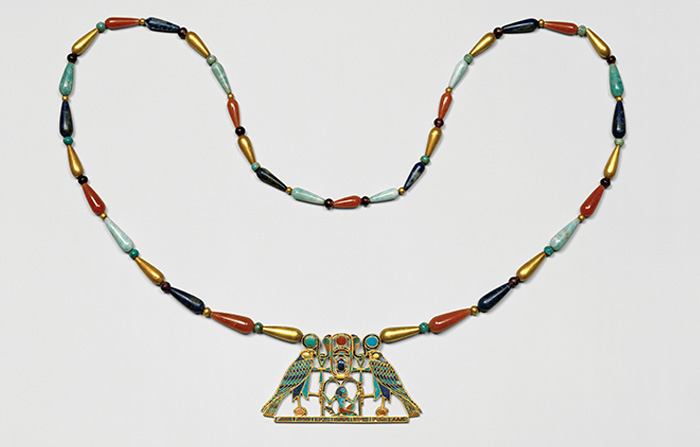
The pharaohs were buried with all their finest possessions, including their jewellery and charms, which would have been seen as a symbol of their status on earth. This was thought to act as a kind of ‘passport’ to the afterlife. At the very least, their names, possessions and knowledge about their culture and lifestyle still live on, just like the architecture they leave behind.
The wearing of charms continued throughout the Roman Empire, and many Christians would wear a small, concealed fish charm to inform other Christians that they followed the same teachings without the fear of persecution.

Charms continued to be used as amulets and talismans throughout the Middle Ages, and were particularly popular when witchcraft was feared by large numbers of an increasingly superstitious population. Kings and knights would also carry charms into battle, believing they gave them protection. Certain charms would act as identifiers to a person's familial, political and trade background.
Once magical superstition began to fade, so did the popularity of charms and their use as a means of protection. To continue to show off their status, nobles and aristocrats replaced their charms with gemstones and jewellery, as global trade and access to precious stones and metals began to grow.

Later still, the mechanical advancements of the Industrial Revolution significantly improved the speeds and methods of mining metals and gemstones. This allowed charms to be mass produced for the first time, bringing down their price and finally making them affordable to the middle classes. Before this, only the affluent could realistically afford to own items of such craftsmanship.
Between the 1300s and 1800s, the popularity of charms wavered a lot - but in the late 1800s, Queen Victoria started to wear them. She was an extremely popular monarch, therefore her clothes and jewellery heavily influenced the trends and fashions of the time. Queen Victoria kickstarted the next significant charm renaissance when she began wearing her charm bracelet, and this trend quickly spread across Europe.
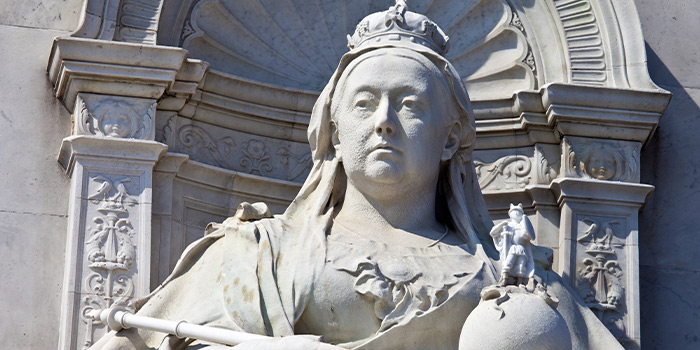
Queen Victoria made an important change to the type of charms that she wore; rather than being for luck or protection, her charms were personalised to her and worn purely for fashion, and this is seen as the beginning of the charm industry as we know it today.
She had Gold bracelet onto which she placed charms that represented members of her family, including Gold lockets with photographs inside them. She even went as far as having locks of hair from her family members, and a miniature portrait of her beloved Prince Albert after he passed away. Queen Victoria loved charm bracelets so much that she would often give them as gifts to others.
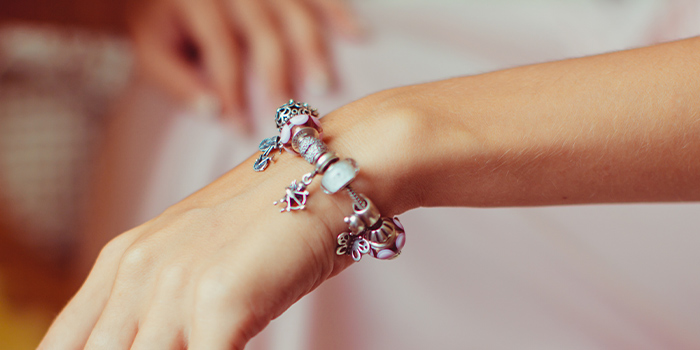
The acceptance of charms by the fashion industry (and their immense popularity at the end of the 19th century) led Tiffany & Co to introduce their first charm bracelet in 1889. The ever-popular design consisted of a single heart charm on a multi-link bracelet, a variation of which is still on sale today.
In the 1920s and 1930s, Diamond charms came into widespread use for the first time, despite the Great Depression, establishing the modern trend of charms set with precious and semi-precious gemstones.
World War II was an unlikely contributor to the history of charms; however, soldiers began collecting small trinkets sourced from local crafters in the areas where they’d been posted. On returning home, they would often present these mementos to their loved ones, and many of them found a home on charm bracelets.
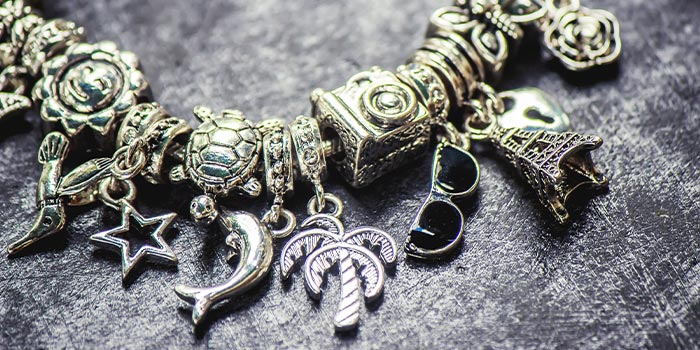
The fabulous 50s and swinging 60s saw charms being adopted by the emerging teenage culture, with a charm bracelet being a common 18th birthday gift. These bracelets would be added to at significant life milestones, such as birthdays, a wedding day and the birth of a child. There were also charms to represent hobbies and interests, as well as birthstones and star signs (a concept now very familiar to charm collectors worldwide).
Pop culture, fashion and glamour icons of the time, such as Elizabeth Taylor, also bought the charm bracelet a vast amount of extra attention. Bracelets of this era solidified the concept of a charm bracelet telling the story of its owner, and many went on to become heirlooms, passed down and added to by the next generation.
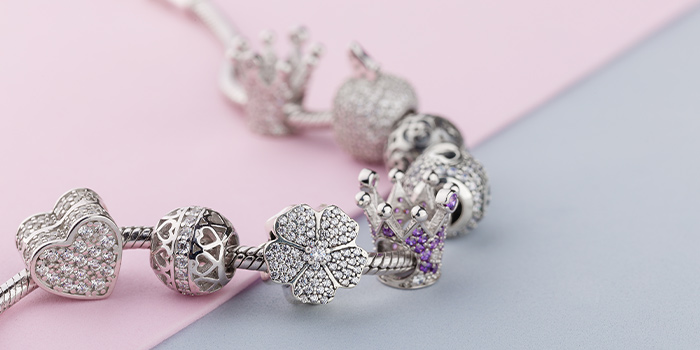
Early to mid-century vintage charm bracelets were sought after by collectors in the 1970s and 1980s, who were less interested in creating something new for themselves and more in finding items with a story and a legacy. The trend of collecting old charms continued into the 90s, as the internet boom made finding and buying vintage pieces even easier.
The start of the new millennium saw the rise of the current charm resurgence. Big fashion brands like Chanel and Louis Vuitton championed new charm collections, and stand-alone brands like Pandora emerged, built entirely around charms. The trend is currently enjoying a prolonged period of mainstream recognition around the globe, and our own charm collections are enjoyed by a huge number of Gemporia customers.
GEMPORIA CHARM COLLECTIONS
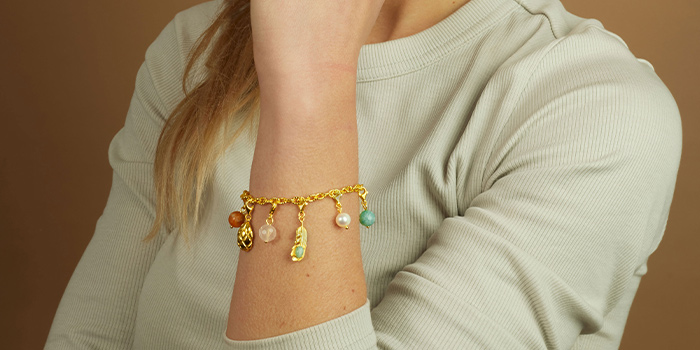
Our charms, as with everything we do, only ever contain genuine gemstones. Small numbers of new charms are regularly introduced, whether they be universally loved icons like hearts, stars and horseshoes to more seasonal designs like Easter eggs, reindeer and butterflies.
The concept may be an ancient one, but collecting charms and telling a story through a personalised piece of jewellery is as timeless as the gemstones they contain. Whether buying for yourself or as a gift for someone else, every unique bracelet will be utterly charming.
We’re very proud of our charm collections and we have two very distinctive brands, both with a wide range of designs to choose from, that have been delighting Gemporia customers for many years.
MILANO CHARMS

These are playful yet meaningful charms, carefully designed to capture those special moments in life with sparkling gemstones in a design for every celebration and occasion. This traditionally-styled collection features designs in Sterling Silver, with each charm featuring a clasp to fix it to one of our selection of bracelets or necklaces.
Diversity and individuality are key, so whether you want a bracelet bursting with beautiful charms or a necklace with a single meaningful one, Milano is adaptable enough to deliver your wish.
KAMA CHARMS

These are contemporary, solid and stylish charms that fit neatly over a bracelet to create a row of designs sitting side by side. The many charms created for this modern slant on the charm bracelet are crafted in Sterling Silver, and there’s a fun design for every occasion.
With many genuine gemstones and traditional concepts in the Kama range you can style the bracelet exactly how you want it, and we even sell stylish ‘stoppers’ to bookend your charm choices to keep them from sliding around the bracelet
POPULAR CHARMS AND THEIR MEANINGS
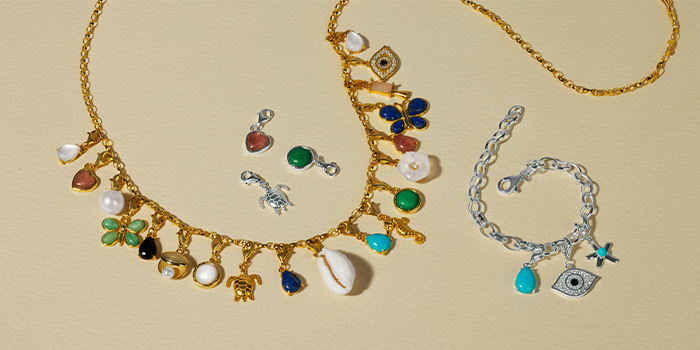
Even though modern-day charm bracelets are built around telling the story of their wearer, some charms still retain their traditional meaning. Here, we explore the meanings behind some of these designs.
BUTTERFLY

Associated with bringing good luck, renewal and dealing with change.
CRESCENT MOON

Traditionally thought to offer protection, but also represents new beginnings.
CROSS

A traditional symbol of Christianity which is also associated with bringing good luck.
DOVE

Heavily linked with freedom, hope and peace. Birds also represent flying the family nest.
FLOWER

Said to represent blossoming love, but also linked with renewal and rebirth.
HEART

Often worn as a symbol of love, and popular in both single and interlocking designs.
HORSESHOE

A traditional and well-known symbol of good luck, fortune and protection.
INFINITY

A reminder of the unlimited possibilities of life and never-ending love.
Charms carry a unique level of sentimentality, and it is important to convey this in every design. From the modern gemstone charms in our Molte collection to our brand-new Kimbie charm bracelets, We have lots of new exciting designs in the pipeline here at Gemporia.

